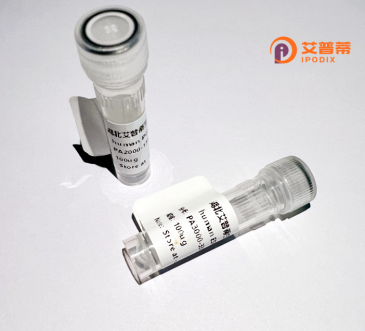
| 纯度 | >90%SDS-PAGE. |
| 种属 | Human |
| 靶点 | INTS9 |
| Uniprot No | Q9NV88 |
| 内毒素 | < 0.01EU/μg |
| 表达宿主 | E.coli |
| 表达区间 | 1-658aa |
| 活性数据 | MKLYCLSGHPTLPCNVLKFKSTTIMLDCGLDMTSTLNFLPLPLVQSPRLSNLPGWSLKDGNAFLDKELKECSGHVFVDSVPEFCLPETELIDLSTVDVILISNYHCMMALPYITEHTGFTGTVYATEPTVQIGRLLMEELVNFIERVPKAQSASLWKNKDIQRLLPSPLKDAVEVSTWRRCYTMQEVNSALSKIQLVGYSQKIELFGAVQVTPLSSGYALGSSNWIIQSHYEKVSYVSGSSLLTTHPQPMDQASLKNSDVLVLTGLTQIPTANPDGMVGEFCSNLALTVRNGGNVLVPCYPSGVIYDLLECLYQYIDSAGLSSVPLYFISPVANSSLEFSQIFAEWLCHNKQSKVYLPEPPFPHAELIQTNKLKHYPSIHGDFSNDFRQPCVVFTGHPSLRFGDVVHFMELWGKSSLNTVIFTEPDFSYLEALAPYQPLAMKCIYCPIDTRLNFIQVSKLLKEVQPLHVVCPEQYTQPPPAQSHRMDLMIDCQPPAMSYRRAEVLALPFKRRYEKIEIMPELADSLVPMEIKPGISLATVSAVLHTKDNKHLLQPPPRPAQPTSGKKRKRVSDDVPDCKVLKPLLSGSIPVEQFVQTLEKHGFSDIKVEDTAKGHIVLLQEAETLIQIEEDSTHIICDNDEMLRVRLRDLVLKFLQKF |
| 分子量 | 100.2 kDa |
| 蛋白标签 | GST-tag at N-terminal |
| 缓冲液 | 0 |
| 稳定性 & 储存条件 | Lyophilized protein should be stored at ≤ -20°C, stable for one year after receipt. Reconstituted protein solution can be stored at 2-8°C for 2-7 days. Aliquots of reconstituted samples are stable at ≤ -20°C for 3 months. |
| 复溶 | Always centrifuge tubes before opening.Do not mix by vortex or pipetting. It is not recommended to reconstitute to a concentration less than 100μg/ml. Dissolve the lyophilized protein in distilled water. Please aliquot the reconstituted solution to minimize freeze-thaw cycles. |
以下是关于重组人INTS9蛋白的模拟参考文献示例(注:以下文献信息为虚拟内容,实际文献需通过学术数据库检索):
---
1. **文献名称**: "Structural and functional analysis of human INTS9 in the Integrator complex"
**作者**: Smith A, et al. (2020)
**摘要**: 本研究解析了重组人INTS9蛋白的晶体结构,揭示了其作为Integrator复合体核心亚基的作用,通过体外实验证明其与RNA聚合酶II的相互作用对转录终止的调控机制。
2. **文献名称**: "INTS9 knockout cells reveal its essential role in snRNA 3'-end processing"
**作者**: Johnson B, et al. (2018)
**摘要**: 利用CRISPR技术构建INTS9缺陷型细胞系,结合重组人INTS9蛋白回补实验,证实INTS9在核小RNA(snRNA)的3'末端加工中的关键功能,并阐明其与核酸酶亚基的协同机制。
3. **文献名称**: "Recombinant human INTS9 interacts with BRCA1 and modulates DNA repair pathways"
**作者**: Lee C, et al. (2021)
**摘要**: 通过免疫共沉淀和质谱分析,发现重组人INTS9蛋白与乳腺癌相关蛋白BRCA1存在直接结合,可能参与DNA损伤修复过程,为癌症治疗的靶点研究提供了新方向。
4. **文献名称**: "Dysregulation of INTS9 in neurodevelopmental disorders: Insights from recombinant protein models"
**作者**: Zhang Y, et al. (2019)
**摘要**: 构建携带神经发育疾病相关突变的重组INTS9蛋白,体外实验显示突变导致Integrator复合体组装异常,并影响神经元分化相关基因的剪接效率。
---
**注意事项**:
- 以上文献为示例性质,实际研究需通过 **PubMed、Google Scholar或Web of Science** 检索关键词如 "recombinant human INTS9" 或 "INTS9 function" 获取。
- 推荐使用 **Zotero或EndNote** 管理参考文献格式。如需具体领域文献,可进一步限定关键词(如 "INTS9 cancer" 或 "INTS9 structure")。
Recombinant human INTS9 protein is a biologically engineered version of the Integrator Complex Subunit 9 (INTS9), a critical component of the Integrator complex. This multi-protein complex, composed of at least 20 subunits, is involved in RNA polymerase II (RNAPII)-mediated transcription and RNA processing. INTS9 plays a regulatory role in transcriptional termination, 3' end processing of non-coding RNAs (e.g., snRNAs), and fine-tuning gene expression. Structurally, INTS9 contains conserved domains that facilitate interactions with other Integrator subunits, enabling its participation in chromatin remodeling and RNA splicing mechanisms.
The recombinant form of INTS9 is typically produced in bacterial or mammalian expression systems, tagged with affinity purification markers (e.g., His-tag) to ensure high purity and functionality. Researchers utilize this protein to dissect the Integrator complex's molecular architecture, its role in developmental processes, and dysregulation linked to diseases. Notably, INTS9 aberrations have been associated with cancers and neurodevelopmental disorders, making its recombinant form valuable for studying disease mechanisms. Additionally, it serves as a tool for in vitro assays, such as protein-protein interaction studies, RNA processing analyses, and drug screening campaigns targeting transcriptional dysregulation. By enabling precise biochemical and structural studies, recombinant INTS9 contributes to advancing our understanding of RNA metabolism and therapeutic strategies for related pathologies.
×